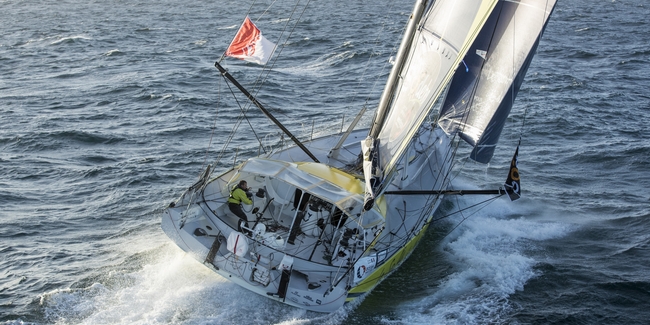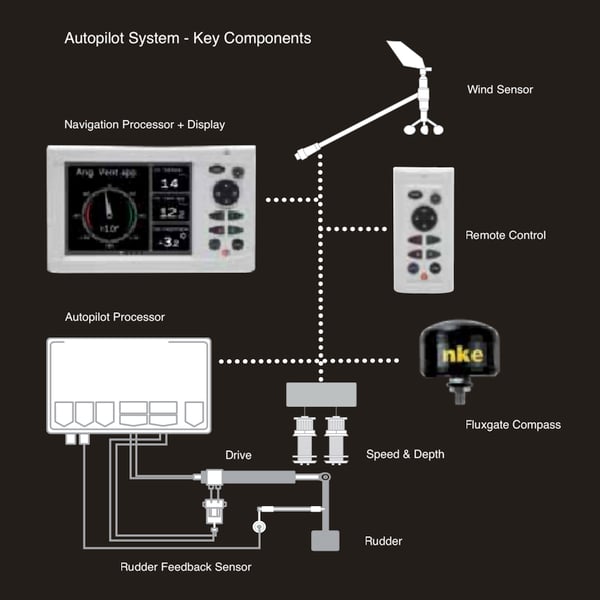
©nke marine electronics
For most cruising and offshore race sailboats, the autopilot is a critical piece of equipment. However, the difference between a “good” and a “not so good” sailing autopilot can be dramatic! Therefore, it is well worth understanding all the necessary components of a good system to create the autopilot package to suit your needs.
There is a lot more to a good sailing autopilot than simply a dive unit, computer and compass. To keep a steady course with variable wind and wave conditions requires many more sensory inputs. However, with today’s computing power and accurate sensors – it is rapidly becoming possible for an autopilot to steer more efficiently than even an experienced race helmsman.
Over the last 10 years sailing autopilots have benefitted from a large amount of R&D investment by the short-handed offshore race community, where this is a "critical success" system.
We can split a sailing autopilot system into two key instrument groups – Navigation and Pilot - but the Pilot system is built on top of a basic navigation system.
Navigation
• Navigation Processor (CPU)
o The computer that brings all the sensor data together and interprets it and allows it to be displayed
• Compass
o Traditionally this has been a single-axis fluxgate compass but increasingly common, and significantly more accurate, is a 9-axis gyrocompass
o In addition to heading they provide data on heel and pitch (adjusted for turn rate) plus acceleration
o This improved boat motion data is a key element to improvements in sailing autopilot performance however it is dependent on having an up to date processor that can handle the complex calculations.
• Wind sensor
o Wind sensors can come in a range of sensitivities and accuracies
o Again – accurate wind data together with the computational power to maintain real-time, clean, Apparent wind data can significantly improve autopilot performance.
• Speed sensors
o Traditionally speed sensors will be through-hull paddle wheels or flush fitting Ultrasonic sensors.
o For the autopilot it is more the computation of acceleration that is important and increasingly there are alternative backup sources of this data i.e. GPS or accelerometers
• Display
o A key element of the Navigation system but not necessary for the pilot
• Depth Sensor
o Again, apart from having a back-up depth alarm (!), it is not required for the autopilot but a standard and essential element of your navigation electronics system.
Autopilot
• Autopilot CPU
o Combines the data from the navigation system with the rudder feedback sensor to operate the autopilot drive unit
• Drive unit
o There are many types of drive available on the market
o Most are either linear drive systems attached to the tiller arm or direct drives connected directly with the rudder stock
o They can be electric or hydraulic
• Rudder feedback sensor
o This is a key component of autopilot operation
o Some autopilot drives incorporate this sensor in the body of the direct drive, which is much easier to setup
o Tuning and maintaining the accuracy of a separate rudder angle sensor can be more challenging and a cause for loss of pilot performance over time.
• Pilot control pad / remote
o A basic but key autopilot component usually located next to the steering position but increasingly supplemented with a remote-control unit which can be worn around the skippers neck.

©nke marine electronics
These are the key components of any autopilot system and if you have a clean sheet of paper it is relatively easy to decide on a preferred supplier and bring a complete plug&play system together. However, most owners are looking to upgrade, or work with legacy systems, and interfacing different systems to ensure compatibility is always a key consideration and usually requires some expert advice.
Conclusion
If you have only a basic navigation system, it is important to be aware that adding the best autopilot on the market will NOT necessarily provide a great result. It is the data coming from the navigation system and the quality of the wind, speed and compass sensors, together with the computational power of the CPU, that are key to overall sailing autopilot performance.
If you have any questions about autopilots, please feel free to email us at support@upffront.com, or click the link below to see our full range:



